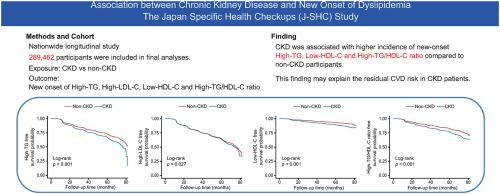Atherosclerosis ( IF 5.3 ) Pub Date : 2021-08-04 , DOI: 10.1016/j.atherosclerosis.2021.08.004 Takaaki Kosugi 1 , Masahiro Eriguchi 1 , Hisako Yoshida 2 , Hikari Tasaki 1 , Fumihiro Fukata 1 , Masatoshi Nishimoto 1 , Masaru Matsui 1 , Ken-Ichi Samejima 1 , Kunitoshi Iseki 3 , Shouichi Fujimoto 3 , Tsuneo Konta 3 , Toshiki Moriyama 3 , Kunihiro Yamagata 3 , Ichiei Narita 3 , Masato Kasahara 3 , Yugo Shibagaki 3 , Masahide Kondo 3 , Koichi Asahi 3 , Tsuyoshi Watanabe 3 , Kazuhiko Tsuruya 4 ,

|
Background and aims
Dyslipidemias are common among patients with chronic kidney disease (CKD) and are a major risk factor for cardiovascular disease. This study aimed to investigate the association between early-stage CKD and new-onset dyslipidemia for each lipid profile.
Methods
This nationwide longitudinal study included data from the Japan Specific Health Checkups (J-SHC) Study. New-onset dyslipidemia was indicated by hypertriglyceridemia (High-TG; ≥150 mg/dL), hyper-LDL cholesterolemia (High-LDL-C; ≥140 mg/dL), or hypo-HDL chelesterolemia (Low-HDL-C; <40 mg/dL) levels according to the guideline of Japan Atherosclerosis Society, or High-TG/HDL-C ratio (≥3.5) which was a good predictor of atherosclerosis. The incidence of new-onset dyslipidemia was compared between participants with and without CKD. Survival curves were used to analyze the incidence of each dyslipidemia.
Results
Of 289,462 participants with a median follow-up period of 3 years, the incidence of High-TG, High-LDL-C, Low-HDL-C, and High-TG/HDL-C ratios were 64.4/1000 person-years, 83.1/1000 person-years, 14.5/1000 person-years, and 39.6/1000 person-years, respectively. The adjusted hazard ratios (95% confidence intervals) for High-TG, High-LDL-C, Low-HDL-C, and High-TG/HDL-C ratio were 1.09 (1.05–1.13), 0.99 (0.95–1.04), 1.12 (1.05–1.18), and 1.14 (1.09–1.18), respectively, in CKD participants as compared to non-CKD participants. Decreased eGFR and presence of proteinuria were independently associated with higher risks for new-onset of High-TG, Low-HDL-C, and High-TG/HDL-C ratios.
Conclusions
CKD was associated with a higher risk of new-onset High-TG, Low-HDL-C, and High-TG/HDL-C ratios, but not High-LDL-C, in the general population. These CKD-specific lipid abnormalities may explain the residual risk for CKD-related cardiovascular disease.
中文翻译:

慢性肾脏病与新发血脂异常之间的关联:日本特定健康检查 (J-SHC) 研究
背景和目标
血脂异常在慢性肾脏病 (CKD) 患者中很常见,并且是心血管疾病的主要危险因素。本研究旨在调查早期 CKD 与新发血脂异常之间的每种血脂特征之间的关联。
方法
这项全国性纵向研究包括来自日本特定健康检查 (J-SHC) 研究的数据。新发血脂异常表现为高甘油三酯血症(高 TG;≥150 mg/dL)、高 LDL 胆固醇血症(高 LDL-C;≥140 mg/dL)或低 HDL 胆固醇血症(低 HDL-C; <40 mg/dL) 水平,根据日本动脉粥样硬化协会的指南,或高 TG/HDL-C 比值 (≥3.5),这是动脉粥样硬化的良好预测指标。比较了患有和不患有 CKD 的参与者之间新发血脂异常的发生率。生存曲线用于分析每种血脂异常的发生率。
结果
在中位随访 3 年的 289,462 名参与者中,高 TG、高 LDL-C、低 HDL-C 和高 TG/HDL-C 比率的发生率为 64.4/1000 人年,分别为 83.1/1000 人年、14.5/1000 人年和 39.6/1000 人年。高 TG、高 LDL-C、低 HDL-C 和高 TG/HDL-C 比率的调整后风险比(95% 置信区间)分别为 1.09 (1.05–1.13)、0.99 (0.95–1.04)与非 CKD 参与者相比,CKD 参与者分别为 1.12 (1.05–1.18) 和 1.14 (1.09–1.18)。eGFR 降低和蛋白尿的存在与新发高 TG、低 HDL-C 和高 TG/HDL-C 比率的较高风险独立相关。
结论
在一般人群中,CKD 与新发高 TG、低 HDL-C 和高 TG/HDL-C 比率的风险较高有关,但与高 LDL-C 的风险无关。这些 CKD 特异性脂质异常可能解释了 CKD 相关心血管疾病的残留风险。


























 京公网安备 11010802027423号
京公网安备 11010802027423号